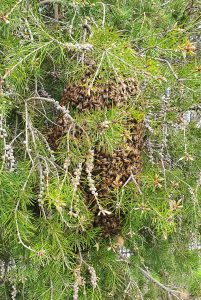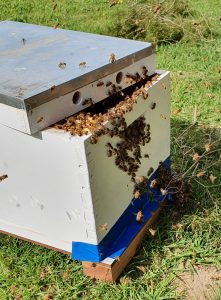Are you one of our club members in need of a swarm? - or - Have you found a swarm?
If you have found a swarm, please contact a swarm collector from the area or near the area in which the swarm is located.
Search for swarm collectors by Postcode : ABA Swarm List by Postcode
If you wish to obtain a swarm for your hive, please contact a swarm collector closest to your area in order to arrange delivery of your hive box.
Please contact the club IF you require any assistance with obtaining a swarm via Goulburn.vp@beekeepers.asn.au
To obtain a swarm, your hive box must be a complete arrangement containing the following items:
- Hive box (one only)
- Base and Lid
- Complete set of frames (usually eight)
- Frames must be wired and fitted with foundation or whatever mechanism your choice of hive requires
- Emlock or strap
- The means to close the hive entrance for transportation to your hive location
- Hive box should be marked with your DPI registration number, see info here Registration Number Tip: Your DPI registration number is displayed on the back of your ABA membership card.
- Your new swarm will need to be moved by you from the collection site to your permanent hive location. You must complete the Tocal College Varroa Mite Online Training Course (takes about 30-40min online and is free) first in order to submit your Hive Movement Declaration Form prior to moving your new hive. Additionally, an alcohol wash must be completed and the result submitted prior to moving the box to its new permanent location. Usually your swarm collector would perform the alcohol wash during the swarm collection.
Once you have received your swarm, we ask that you pay $40 into the Goulburn District Beekeepers Club bank account. Your swarm collector will provide our bank details.
**Please note that MOST swarm collectors are willing to collect swarms on the club's behalf. This is a fund raiser for our club and means swarms collected will be sold to our club members in order for them to establish their beekeeping practice.
Click this link to find the swarm collectors list:
Spring is Honey Bee Swarm Season
Have you ever wondered what to do if you should you find a swarm of bees? Swarming happens mostly in spring time and is usually triggered by the bees running out of space in their hives. During the process of swarming, a bee colony decides to split into two or more swarms. These swarms leave the original hive in order to find a new home.
Encountering a large group of swarming honey bees can be daunting as the swarm is quite noisy and looks like a thick cloud of insects. However, if you are confronted with a buzzing cluster - don’t panic! At this stage they are heading for temporary residences such as a tree branch where they cluster into a dense mass of bees about the size of a football. Scout bees then go looking for a new permanent home. In this state bees have full bellies of honey to keep them going for a few days and they are therefore particularly docile.
Sadly, many beehives were lost in bush fires in recent years and we should be pleased to see swarms of bees. They are obviously important pollinators and if they are swarming, they are creating a new colony
If you spot a swarm, please do not disturb the bees and contact a swarm collector as soon as possible. Beekeepers sometimes may ask for a small collection fee. Most beekeepers will not remove bees from buildings.
** Please note: Bees that have already taken up residence in a permanent location such as inside a brick wall or inside a chimney are not a swarm of bees, they are an established hive.


